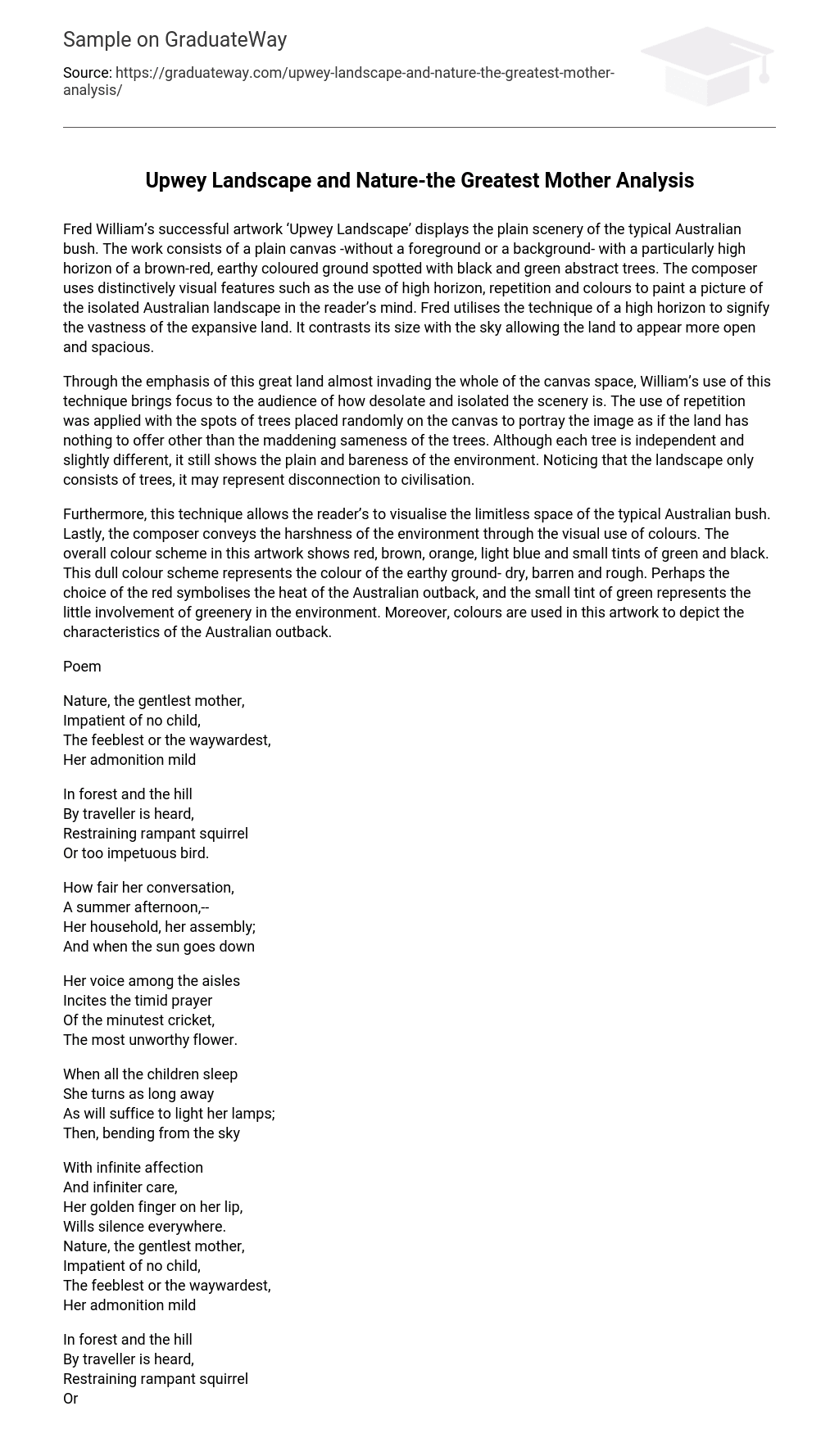Fred William’s successful artwork ‘Upwey Landscape’ displays the plain scenery of the typical Australian bush. The work consists of a plain canvas -without a foreground or a background- with a particularly high horizon of a brown-red, earthy coloured ground spotted with black and green abstract trees. The composer uses distinctively visual features such as the use of high horizon, repetition and colours to paint a picture of the isolated Australian landscape in the reader’s mind. Fred utilises the technique of a high horizon to signify the vastness of the expansive land. It contrasts its size with the sky allowing the land to appear more open and spacious.
Through the emphasis of this great land almost invading the whole of the canvas space, William’s use of this technique brings focus to the audience of how desolate and isolated the scenery is. The use of repetition was applied with the spots of trees placed randomly on the canvas to portray the image as if the land has nothing to offer other than the maddening sameness of the trees. Although each tree is independent and slightly different, it still shows the plain and bareness of the environment. Noticing that the landscape only consists of trees, it may represent disconnection to civilisation.
Furthermore, this technique allows the reader’s to visualise the limitless space of the typical Australian bush. Lastly, the composer conveys the harshness of the environment through the visual use of colours. The overall colour scheme in this artwork shows red, brown, orange, light blue and small tints of green and black. This dull colour scheme represents the colour of the earthy ground- dry, barren and rough. Perhaps the choice of the red symbolises the heat of the Australian outback, and the small tint of green represents the little involvement of greenery in the environment. Moreover, colours are used in this artwork to depict the characteristics of the Australian outback.
Poem
Nature, the gentlest mother,
Impatient of no child,
The feeblest or the waywardest,
Her admonition mild
In forest and the hill
By traveller is heard,
Restraining rampant squirrel
Or too impetuous bird.
How fair her conversation,
A summer afternoon,–
Her household, her assembly;
And when the sun goes down
Her voice among the aisles
Incites the timid prayer
Of the minutest cricket,
The most unworthy flower.
When all the children sleep
She turns as long away
As will suffice to light her lamps;
Then, bending from the sky
With infinite affection
And infiniter care,
Her golden finger on her lip,
Wills silence everywhere.
Nature, the gentlest mother,
Impatient of no child,
The feeblest or the waywardest,
Her admonition mild
In forest and the hill
By traveller is heard,
Restraining rampant squirrel
Or too impetuous bird.
How fair her conversation,
A summer afternoon,–
Her household, her assembly;
And when the sun goes down
Her voice among the aisles
Incites the timid prayer
Of the minutest cricket,
The most unworthy flower.
When all the children sleep
She turns as long away
As will suffice to light her lamps;
Then, bending from the sky
With infinite affection
And infiniter care,
Her golden finger on her lip,
Wills silence everywhere.
Emily Dickinson’s poem ‘Nature- the gentlest mother’ is about nature being the mother of all that lives on this earth. The poem reveals the nurturing characteristics of Mother Nature and her roles upon caring for her children through day to night. The composer uses distinctively visual features such as personification, metaphor, and symbolism to create a vivid image of the peaceful power of Mother Nature. Dickinson uses personification to refer nature as a motherly figure to give prominence to her sweet tempered characteristics. The quote “When all children sleep, she turns as long away, as will suffice to light her lamps” represents a mother tucking her child into bed, and watching over from the night sky as the lamps act in place of stars.
This allows the readers to visualise a clear motherly figure through the input of caring parental qualities. The composer utilises the technique of metaphors to express nature as a gentle mother and the living creatures (such as the squirrel, cricket, and bird) as her children. The use of this technique stimulates an image of nature as a perpetual guardian of both living and nonliving creatures on earth into the reader’s mind. This is shown through the passage “Incites the timid prayer Of the minutest cricket, the most unworthy flower” as it represents how nature is so gentle that it kindly encourages even the tiniest creatures and unworthy flowers to voice themselves quietly as though in prayers.
Symbolism is used to suggest that nature can be interpreted as a place of worship as references are made in the poem through the mention of ‘aisles’, and ‘prayers’. Dickinson has carefully used this as a distinctively visual technique to symbolise the natural environment as a place of honouring and glorification. This technique lets the readers to visualise the amount of respect and love Mother Nature holds.





